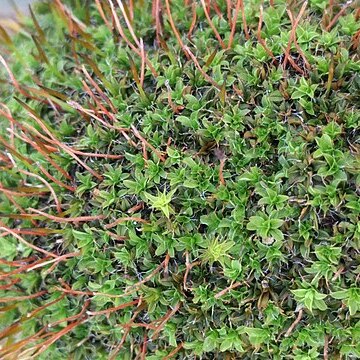Plants small, in loose tufts, dark to olive-green; corticolous. Stems 2-4 mm high, unbranched; in section central strand present, inner cortical cells large, thin-walled, outer cortical cells in 1-2 rows, smaller, red-brown. Leaves appressed, incurved dry, widely spreading wet, comose; spathulate to broadly ungulate, 2 mm long; apex emarginate to retuse; margins plane, entire. Costa excurrent as long, smooth, hyaline awn; ventral superficial cells quadrate, thin-walled, papillose, dorsal superficial cells linear, strongly incrassate, smooth; in section with 2 guide cells, ventral cells in one layer, thin-walled, papillose, dorsal stereid band large, 7-8 cells thick. Laminal cells quadrate to hexagonal, with 4-8 C-shaped papillae over lumen; basal cells larger, quadrate to shortly rectangular, smooth. Propagulae leaf-like, in large numbers at stem apex; elliptical; ecostate; apical cell elongate, pellucid, body cells hexagonal to subhexagonal, papillose, chlorophyllous. Sporophyte not known in Africa, but described from Australia (Stone, 1971) as: Perichaetial leaves little differentiated. Seta 5-9 mm long, yellow above, reddish below; capsule short-cylindrical 2.0-2.4 mm long, slightly curved, brownish; peristome to 1.0 mm high, teeth linear, papillose, twisted once counter-clockwise, above a short basal membrane, 0.3 mm high; operculum narrowly conical, 1.5-1.7 mm long; calyptra cucullate, 2.5-3.0 mm long; spores 8-10 µm, slightly papillose, greenish brown.
More
Stems 1-3(-5) mm. Leaves infolded and somewhat twisted when dry, erect-spreading when moist, spatulate, 1-1.75 × 0.5-0.75 mm; margins plane (or somewhat erect), crenulate; apices obtuse, blunt, or emarginate; costa excurrent into a conspicuously tapered, smooth, yellowish or hyaline awn 1/5-1/2 the length of the leaf, yellow or red, rounded and smooth on abaxial surface; basal cells rather abruptly differentiated, often with thickened cross-walls, usually extending slightly farther up the margin than near the costa; distal cells quadrate to hexagonal, 10-15 µm, bulging, with about 4 papillae per cell, the outermost row of cells less papillose. Specialized asexual reproduction as propagula borne at the tip of the stem and in axils of distal leaves, fusiform, green, ecostate, papillose, with an elongate terminal cell, occasionally as several cells. Sexual condition dioicous or autoicous. Seta red, 5-15 mm. Capsule red, 3-5 mm, straight, with a distinct neck; operculum 1-2 mm, red; peristome 0.5-1 mm, basal membrane 1/2 the total length, red. Spores 10-16 µm, papillose.

